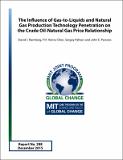The Influence of Gas-to-Liquids and Natural Gas Production Technology Penetration on the Crude Oil-Natural Gas Price Relationship
Author(s)
Ramberg, D.J.; Chen, Y.-H.H.; Paltsev, S.; Parsons, J.E.
DownloadMITJPSPGC_Rpt288.pdf (949.9Kb)
Metadata
Show full item recordAbstract
The paper examines conditions under which gas-to-liquids (GTL) technology penetration shifts the crude oil-natural gas price ratio. Technologies that enable direct substitution across fuels, as GTL does, may constrain the price ratio within certain bounds. We analyze the forecasted evolution of the crude oil-natural gas price ratio over the next several decades under alternative assumptions about the availability and cost of GTL and its natural gas feedstock. We do this using a computable general equilibrium model of the global economy with a focus on the refinery sector in the U.S. Absent GTL, a base case forecast of global economic growth over the next few decades produces dramatic increases in the oil-natural gas price ratio. This is because there is a more limited supply of low-cost crude oil resources than natural gas resources. The availability of GTL at conventional forecasts of cost and efficiency does not materially change the picture because it is too expensive to enhance direct competition between the two as fuels in the transportation sector. GTL only modulates the increasing oil-gas price ratio if both (i) natural gas is much cheaper to produce, and (ii) GTL is less costly and more efficient than conventional forecasts.
Date issued
2015-12Publisher
MIT Joint Program on the Science and Policy of Global Change
Citation
Report 288
Series/Report no.
MIT Joint Program Report Series;288